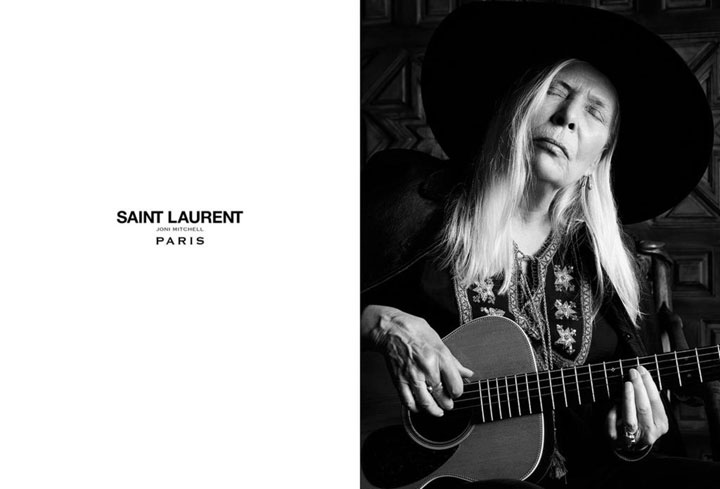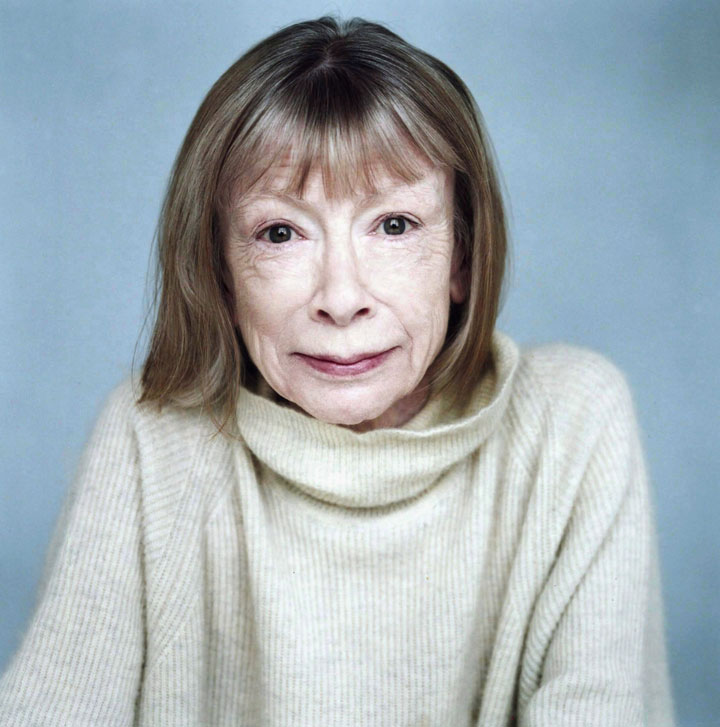TORONTO – Joni Mitchell and Joan Didion are well into their golden years, but the Canadian music icon and American literary legend are emerging as fashion’s freshest faces with each fronting separate campaigns for two leading luxury labels.

The image of a sunglasses-sporting Didion set social media and the fashion world ablaze when the 80-year-old writer was featured as part of the spring-summer 2015 campaign for Celine.
Saint Laurent recently tweeted black-and-white snapshots of a tranquil Mitchell at her Bel Air, Calif., home captured by the label’s designer, Hedi Slimane. Holding an acoustic guitar, the 71-year-old singer-songwriter is dressed in a folk tunic, a leather cape by Slimane and a classic fedora as part of the Saint Laurent Music Project, a campaign of rock stars in iconic and permanent pieces of the collection.
READ MORE: Canada’s Joni Mitchell models for Saint Laurent
“There’s a lot of mystique being taken out of fashion, and what these women have is mystique,” said Suzanne Boyd, editor-in-chief of Zoomer Magazine.
“They have their own style. They’ve never followed fashion. They’ve just been who they are and there’s nothing more stylish or chic than that – and they’re not playing in the same sandbox. So what does fashion love more than anything else but newness?

Get daily National news
“To the fashion eye, they’re new. It’s new to go after women like this, that it’s not about beauty or glamour – it’s about true achievement and authenticity.”
Last fall, 69-year-old Helen Mirren was announced as the new face of L’Oreal, joining fellow Oscar winner Jane Fonda, 77, in representing the brand alongside notable women half – and even a third – of their ages.
In recent years, Ines de la Fressange has walked in shows for Jean Paul Gaultier and Chanel in her 50s, while nonagenerian style icon Iris Apfel created a cosmetics collection with MAC and appeared in ads for the brand.
Marketing and branding expert Lina Ko said she sees Mitchell and Didion as the latest evolution in the movement toward mature models which aims at celebrating individuality.
“They’re icons in their own categories, but they’re not style icons,” said Ko, author of boomerwatch.ca, a blog providing insights on marketing to baby boomers.
“I think the particular fashion brands they’re always wanting to be different … they want to be edgy. And it is probably generating a lot of attention because they’re using these mature models, and they’re in a way saying the marketing strategy is no longer just (about) external beauty, but inherent beauty in what they’ve accomplished. The mind is as important as beauty.”
Ko sees it as a trend that will endure, notably because the boomer demographic “is here to stay for another 15 years.”
“We’re one-third of the population, but we control more than 70 per cent of the disposable income, so as marketers, they probably need to think.”
While older women have been featured in designer shows, the runway is still far from achieving true diversity in casting, as young, slender models remain in the catwalk majority.
“Because samples are made in a particular size – either a size two or four – it’s not going to fit a lot of mature women,” said Ben Barry, assistant professor of equity, diversity and inclusion at the school of fashion at Ryerson University in Toronto.
“As you age, your body changes, so a lot of these women, they may not be plus size, but they’re certainly maybe a size 10 or a size 12; and because of that, they’re not going to fit into the samples on the runway.”
Barry said incorporating older women into runway shows will require a more sizable institutional shift in the way fashions are created and designed. But he credited social media and blogs like Advanced Style which features stylish seniors in helping pioneer the idea now being embraced by marketers – that the love of fashion isn’t bound by demographics.
“Certainly in the fashion industry from a business perspective, a stereotype existed that once women hit a particular age they no longer cared about clothes, they no longer valued their appearance, they were no longer deemed culturally beautiful.
“I think we’ve seen blogs really challenge that by showing women of all ages, whether they’re women who work in the industry or just regular women on the street, and showing them as beacons and champions of style and, really, inspiration for so many women.”









Comments